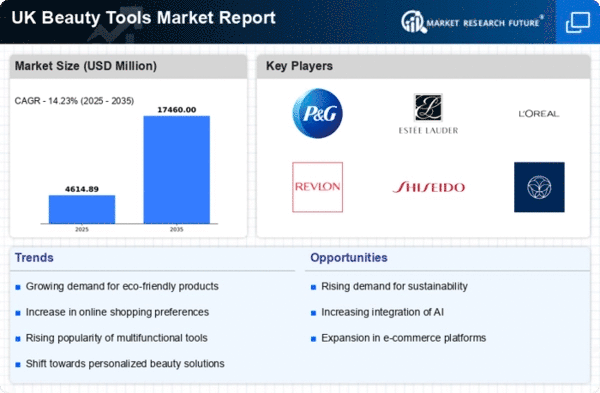The beauty tools market exhibits a dynamic competitive landscape characterized by rapid innovation and strategic maneuvering among key players. Major companies such as Procter & Gamble (US), L'Oréal (FR), and Estée Lauder (US) are at the forefront, each leveraging distinct strategies to enhance their market presence. Procter & Gamble (US) focuses on sustainability and eco-friendly product lines, which resonates with the growing consumer demand for environmentally conscious options. L'Oréal (FR) emphasizes digital transformation, investing heavily in e-commerce platforms and AI-driven beauty solutions, thereby enhancing customer engagement and personalization. Estée Lauder (US) is known for its aggressive expansion into emerging markets, particularly in Asia, which is expected to drive significant growth in the coming years. Collectively, these strategies not only shape their individual trajectories but also intensify the competitive environment within the market.
Key business tactics employed by these companies include localizing manufacturing and optimizing supply chains to enhance efficiency and responsiveness to market demands. The competitive structure of the beauty tools market appears moderately fragmented, with a mix of established brands and emerging players vying for market share. The influence of key players is substantial, as their strategic initiatives often set industry standards and trends, compelling smaller companies to adapt or innovate in response.
In October 2025, L'Oréal (FR) announced a partnership with a leading tech firm to develop an AI-driven beauty assistant, which is poised to revolutionize customer interaction and product recommendations. This strategic move underscores L'Oréal's commitment to integrating technology into its offerings, potentially enhancing customer satisfaction and loyalty. The partnership may also position L'Oréal as a pioneer in the digital beauty space, setting a benchmark for competitors.
In September 2025, Estée Lauder (US) launched a new line of beauty tools designed specifically for the Asian market, reflecting its strategic focus on regional expansion. This initiative not only caters to local preferences but also demonstrates the company's agility in responding to diverse consumer needs. By tailoring products to specific markets, Estée Lauder is likely to strengthen its foothold in Asia, which is becoming increasingly lucrative for beauty brands.
In August 2025, Procter & Gamble (US) unveiled a new sustainability initiative aimed at reducing plastic waste in its beauty tools packaging. This move aligns with the growing consumer expectation for brands to adopt sustainable practices. By prioritizing eco-friendly solutions, Procter & Gamble may enhance its brand image and appeal to environmentally conscious consumers, potentially driving sales growth in a competitive market.
As of November 2025, current trends in the beauty tools market are increasingly defined by digitalization, sustainability, and the integration of AI technologies. Strategic alliances are becoming more prevalent, as companies recognize the value of collaboration in enhancing innovation and market reach. Looking ahead, competitive differentiation is likely to evolve, shifting from traditional price-based competition to a focus on innovation, technological advancements, and supply chain reliability. This transition may redefine how companies engage with consumers, ultimately shaping the future landscape of the beauty tools market.






















Leave a Comment